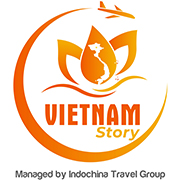For the Vietnamese people, the Vietnam Newyear, known locally as Tet (pronounced close to “Tet”), is profoundly significant. It’s not merely a new year celebration; it stands as the most important public festival of the year. Tet is a vibrant tapestry woven with threads of ancient traditions, deep family bonds, and spiritual renewal. This grand event celebrates the arrival of spring according to the lunar calendar, typically falling in late January or early/mid-February. Vietnam transforms into a kaleidoscope of colour, excitement, and heartfelt customs. For travellers from India considering a Vietnam tour, experiencing Tet offers an unparalleled journey into the very soul of Vietnamese culture.
This festival is not only celebrated in homes but is also marked by public festivities throughout the country. The vibrant displays of flowers, traditional foods, and family gatherings create an atmosphere that is both captivating and enriching.
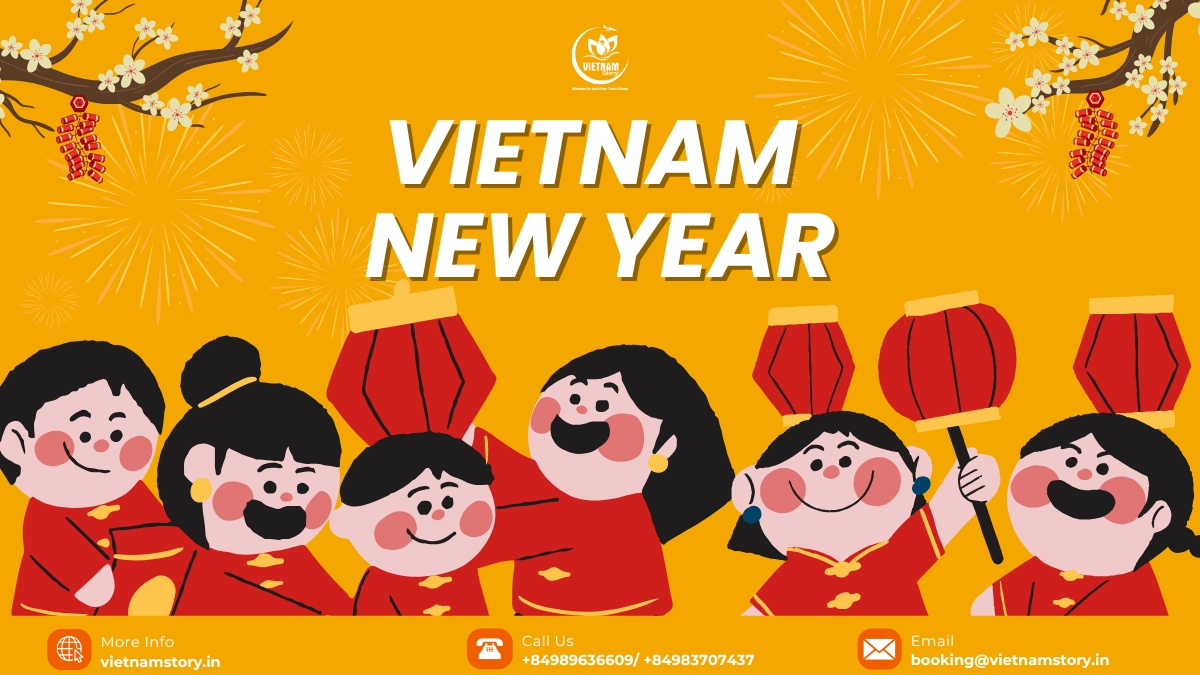
What is the Tet Festival (Vietnam Newyear)?
The full name for Tet is Tet Nguyen Dan, meaning the “Feast of the First Morning of the First Day.” It marks the beginning of the Lunar New Year cycle and the arrival of spring. While its date often coincides with Chinese New Year, Tet is a uniquely Vietnamese festival with origins tracing back to the Dai Viet kingdom in the 10th century AD. It’s a crucial time for Vietnamese people to express respect to their ancestors and welcome the new year surrounded by family members. Think of it as having similarities to major family-centric festivals in India, but with distinct Vietnamese traditions. It’s a period deeply rooted in agricultural cycles, family connections, and hopes for prosperity.
When Is the Vietnam Newyear (Tet Festival)?
The dates for Tet change annually because it follows the lunisolar calendar. It generally falls in late January or early to mid-February. The official public holiday typically lasts for about seven days, though the celebratory atmosphere can extend longer. The exact days off are often adjusted to bridge weekends, creating a longer break.
- Tet 2026: The main day falls on February 17, 2026. Expect official holidays around February 16th to 20th (Monday to Friday, subject to final government confirmation).
- Tet 2027: The main day falls on February 6, 2027. Expect official holidays around February 5th to 11th (Friday to Thursday, subject to final government confirmation).
Knowing these dates is essential when planning your Vietnam tour.
How Is Tet Celebrated? Pre-Tet Preparations and Traditions
As Tet is the most significant festival, preparations begin well in advance, embodying a spirit of cleansing and renewal.
- Cleaning and Decorating: Weeks before Tet, families undertake a thorough cleaning of their homes and businesses. This is a vital ritual believed to “sweep away” bad luck from the old year, making space for good fortune. Homes are then adorned with vibrant decorations. Key items include:
- Hoa Mai: Yellow apricot blossoms, especially popular in Southern Vietnam, symbolizing good luck and wealth.
- Hoa Dao: Peach blossoms, prevalent in Northern Vietnam, symbolizing spring and vitality.
- Kumquat Trees: Small citrus trees laden with fruit, representing prosperity, fertility, and family reunion.
- Red banners and couplets bearing auspicious wishes.
- Ancestor Worship and Temple Visits: Many families visit the graves of their ancestors in the week prior to Tet to clean them and invite the spirits home for the celebration. Visiting temples to pray for luck and make offerings is common both before and immediately after Tet.
- Shopping and Food Preparation: Acquiring new clothes signifies a fresh start. Preparing special Tet foods is paramount, often a communal family activity involving dishes made with great care and cultural significance.
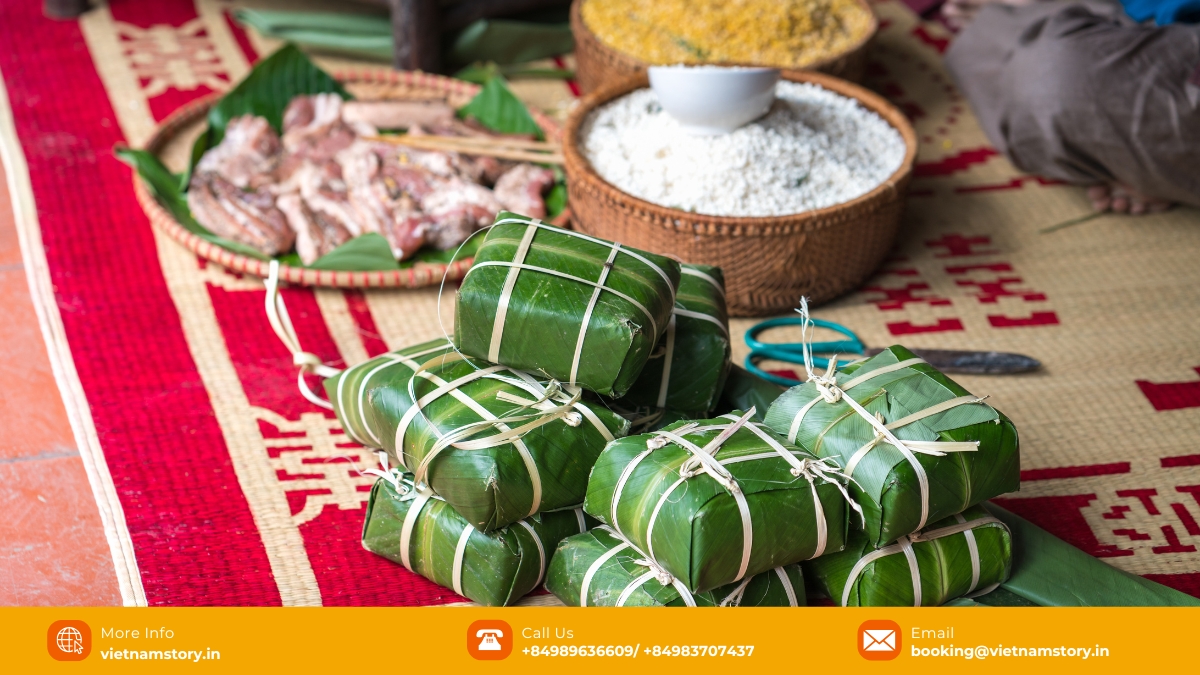
Tet Celebrations: New Year’s Eve and Beyond
- New Year’s Eve (Đêm Giao Thừa): This is a sacred time for reflection and anticipation. Families gather for prayers, honouring ancestors and deities, wishing for health and happiness. As midnight strikes, fireworks often illuminate the skies (spectacularly in cities like Da Nang, and recently Hanoi featured drone shows), believed to scare away evil spirits. The first moments of the Vietnam Newyear are met with hope, shared meals symbolising unity, and exchanged wishes.
- New Year’s Day (Mùng 1 Tết) & Following Days: The first day is usually quiet, spent with immediate family. It’s customary for everyone, especially children, to wear new clothes. A key tradition is visiting relatives and respected figures, starting with the closest family. Younger members show respect to elders and receive “Li Xi” – lucky money in red envelopes – symbolizing good fortune and blessings. These visits continue for several days, strengthening community bonds. You’ll hear greetings like “Chúc Mừng Năm Mới” (Happy New Year) or “An Khang Thịnh Vượng” (Wishing you security, health, and prosperity).
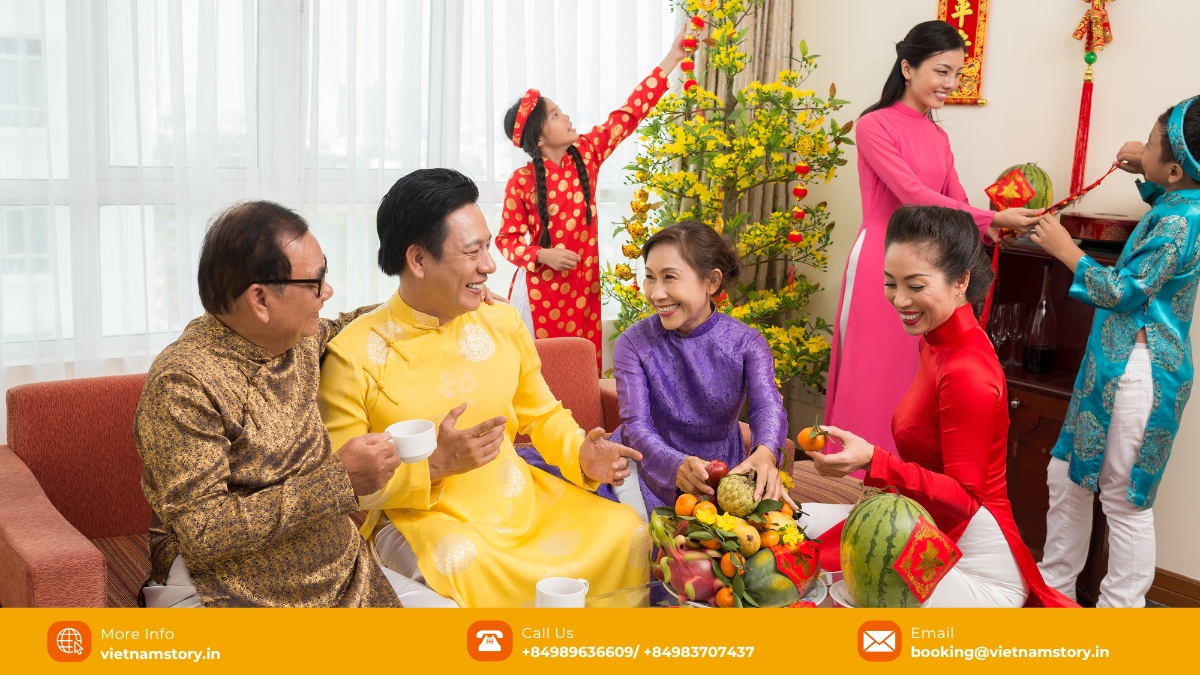
Traditional Foods and Activities During Vietnam Newyear
Food is central to Tet, with many dishes carrying deep symbolism. Special meals are prepared that hold cultural significance and are often enjoyed together with family.
The act of sharing food during Tet strengthens family ties and reinforces the cultural heritage that is celebrated during this significant period.
- Banh Chung / Banh Tet: These iconic sticky rice cakes are indispensable. Banh Chung (square, popular in the North) and Banh Tet (cylindrical, popular in the South) are made with glutinous rice, mung beans, and pork, wrapped in leaves. They symbolize gratitude to ancestors and the earth/heaven.
- Gio Lua: Vietnamese pork sausage, a common part of the Tet feast.
- Thit Kho Tau: Braised pork belly with eggs in caramel sauce, representing abundance and family happiness.
- Pickled onions or vegetables, spring rolls, various sweets (Mut Tet), and abundant fruit platters are also common.
- Having a big family meal together is a cornerstone of the celebration.
Traditional activities like lion and dragon dances (believed to bring luck), folk games, and visiting flower markets add to the festive atmosphere.
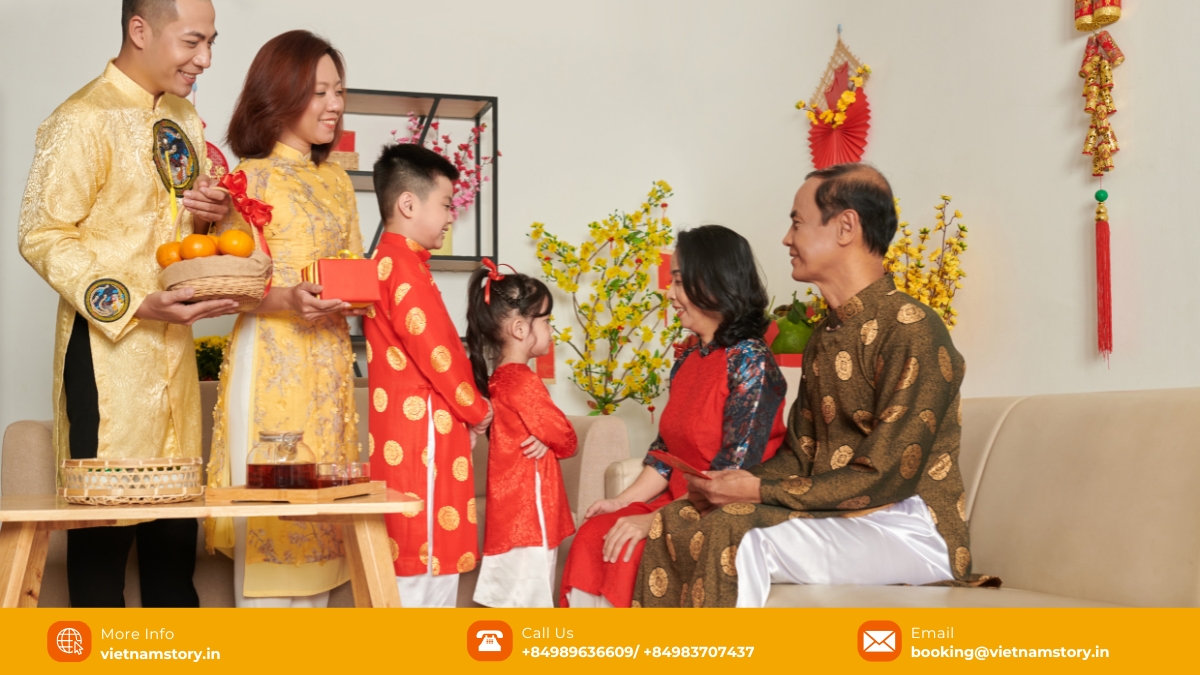
Traveling in Vietnam During Tet: What Indian Tourists Should Know
Visiting Vietnam during the Tet holiday offers a unique cultural immersion but requires careful planning. Is it a good time for your Vietnam tour? Consider these points:
Challenges:
- Transportation: Flights, buses, and trains are extremely busy about 1 week before and after Tet as people travel home or back to work. Prices surge, and tickets sell out months in advance. Book VERY early. (Note: If booking a tour with us, private vehicle arrangements mitigate short-distance transport worries).
- Accommodation: Most hotels remain open, but booking early is crucial for choice and better rates. Some hotels may increase prices during the peak Tet days.
- Sightseeing Closures: While some tourist sites stay open, many museums, mausoleums, indoor exhibition places, and art houses will be closed for at least the first 3 days of Tet. Floating markets in the Mekong Delta will also be closed. Plan your itinerary accordingly.
- Restaurant Closures: Many local restaurants close during Tet, especially in smaller towns. This might not be the best time for dedicated culinary tours focused on street food. Hotel restaurants usually remain open.
- Shop Closures: Many shops close for the first few days. However, some sellers might offer good prices afterwards to start the year with smooth sales.
- Bank Closures: Banks will be closed for the entire holiday period. Plan your finances accordingly.
Opportunities:
- Cultural Immersion: Witness Vietnam at its most vibrant and traditional. Streets are elaborately decorated, and you can observe unique customs firsthand.
- Immerse yourself in Vietnam’s festive calendar: Experience the joyous mood, witness families celebrating, and admire colorful decorations like lanterns and flowers.
- Quieter Streets & Beaches: During the main days of Tet (especially the first day), major city streets become surprisingly quiet with light traffic. Beaches may also be less crowded than usual, offering tranquility.
- Special Events: Some hotels and travel agents organize special Tet celebrations or dinners for guests.
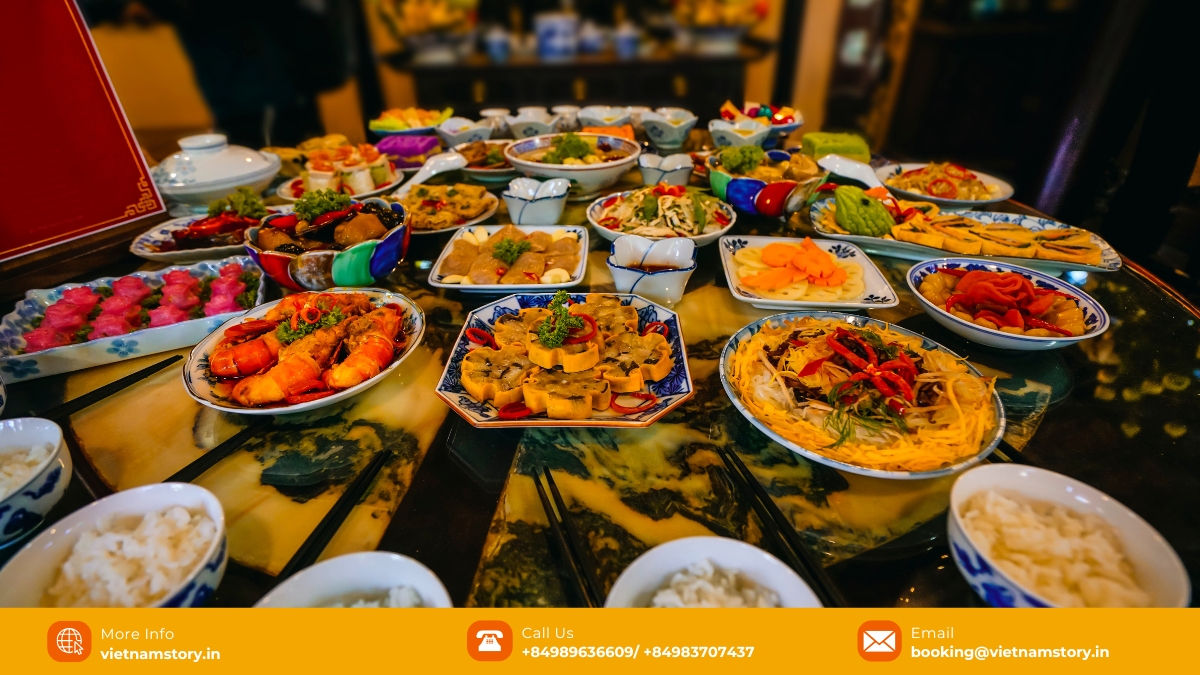
Tips for Traveling During Vietnam Newyear (Tet)
- Book Everything Early: Plan and book your Vietnam tour, flights, and hotels at least 2-4 months in advance. This guarantees availability, potentially better prices, and more choices.
- Plan Itinerary Wisely: Schedule visits to museums, mausoleums, etc., just before or after the main Tet days (first 3 days). Use the core Tet days for relaxing, exploring quieter streets (like Hanoi Old Quarter), visiting open temples, or enjoying beaches.
- Dining Options: Be prepared for restaurant closures. Hotel restaurants are a reliable option. Stock up on some snacks.
- Currency Exchange: Change currency before the holiday or use hotel exchange services if necessary (rates might be less favourable). ATMs can run out of cash in some areas.
- Bargaining Etiquette: Avoid bargaining aggressively, especially on the first days of Tet, as it’s considered unlucky for vendors. If you must negotiate, do so politely and gently. The first sale of the year is important.
- Respect Traditions: Be mindful of local customs, dress modestly when visiting temples, and embrace the festive spirit respectfully. Avoid cleaning or sweeping on the first day of Tet if staying in local accommodation.
Vietnam Weather During Tet Festival
Tet usually falls in January or February, coinciding with generally pleasant weather across Vietnam, although it varies by region. This makes it a perfect time for travelers to explore.
Understanding the regional differences in weather can help plan outdoor activities during your visit.
- North Vietnam (Hanoi, Halong Bay): Expect cool and dry weather, sometimes misty or drizzly. Average temperatures hover around 17°C (63°F). Pack layers.
- Central Vietnam (Hoi An, Danang, Hue): Generally dry and bright with comfortable temperatures. Average temperatures are around 25°C (77°F).
- South Vietnam (Ho Chi Minh City, Mekong Delta): Warm, dry, and sunny. Average temperatures range from 25-28°C (77-82°F). Ideal beach weather.
Conclusion: Embracing the Vietnam New Year
Vietnam Newyear (Tet) is undeniably more than just a holiday; it’s a profound cultural immersion, a time of vibrant renewal, strong family connections, and deeply felt celebrations grounded in Vietnamese tradition and ancestor reverence. While traveling during Tet presents logistical challenges like closures and booking rushes, the opportunity to witness the country’s most important festival offers an unforgettable experience for visitors from India. By understanding the significance of Tet Nguyen Dan, planning meticulously, and respecting local customs like the importance of Banh Chung or the giving of Li Xi, you can navigate the holiday period successfully and gain a much deeper appreciation for the richness and dynamism of Vietnamese culture. Prepare well in advance, and your Vietnam tour during Tet can be truly special. Don’t miss experiencing the Vietnam New Year festivities firsthand.











